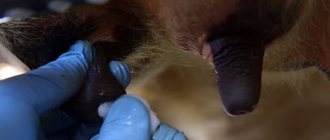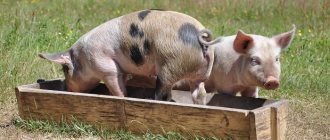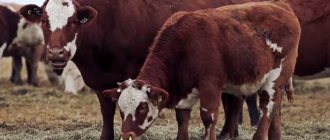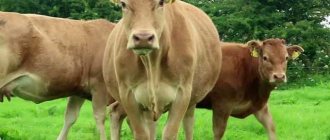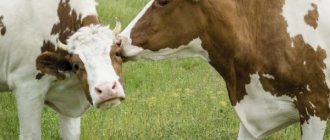Livestock » Cows and bulls
0
1420
Article rating
Kira Stoletova
One of the most common diseases in cattle is brucellosis in cows. Brucellosis can also be diagnosed in sheep, goats and pigs, but is not found in poultry. What is important, brucellosis in cattle can be a source of danger to humans, being transmitted if the latter comes into contact with a sick animal or through consumption of milk and meat from infected livestock. It is not recommended to treat brucellosis in cows, since it does not bring the desired results, but worsens the symptoms and the current quarantine situation.
Brucellosis in cows
Reasons for the development of the disease
Brucella bacteria enter the animal's body through water, food, insect bites, and even from the environment (through mucous membranes or microtraumas on the surface of the skin).
Brucellosis has many ways of spreading and quickly affects the entire population.
Bacteria penetrate through the lymphatic ducts into local lymph nodes and accumulate there. If the concentration of bacteria that entered the body was low, or the cow had good immunity, the body can cope with the infection without outside help. However, self-healing is rare.
[adsp-pro-4]
Most often, bacteria survive a short incubation period (2–3 weeks) and manifest themselves. Brucellosis becomes a generalized form, and microorganisms enter the internal organs of the animal through the blood. At this moment, the first symptoms of brucellosis appear, and the animal becomes a carrier of the infection and poses a danger to surrounding people and animals.
How the disease is transmitted
Infection of cattle occurs in various ways, but infection through the fecal-oral route is common. The spread of infection is rapid; healthy animals quickly become infected from sick ones. Sometimes the penetration of bacteria occurs through a household method when bacteria enter microdamages on the surface of the mucous membranes.
Infection also occurs through contaminated water, feed, and bedding. Penetration of bacteria is possible through microdamages on the epidermis, through the digestive tract and organs of the respiratory system.
Often the disease is diagnosed in those animals that are kept in private farming and household enterprises, often during the period of walking on pasture, when the cows are in contact with each other.
Important! Sometimes outbreaks of the disease occur after new animals are brought into the farm, if quarantine rules are not followed, and vaccination is not carried out.
How does brucellosis manifest in cows?
When bacteria penetrates the internal organs of an animal, it develops characteristic symptoms. However, often the picture of the disease turns out to be blurry: if the cow eats well and lives in normal sanitary conditions, then the signs of brucellosis may appear weakly. Only laboratory testing can confirm the diagnosis.
Symptoms of brucellosis in cows:
With brucellosis, the joints of cows and bulls become swollen.
- swelling of the external genitalia and udder 2–3 days before the abortion;
- mucous brown or clear discharge from the genitals a few hours before the abortion;
- spontaneous abortions at 5–8 months of pregnancy (50–90% of cow pregnancies end in miscarriages);
- the birth of a stillborn or frail and non-viable calf;
- retention of the placenta (placenta) in the uterine cavity for more than 6–8 hours from the moment of birth;
- endometritis after childbirth with copious purulent discharge from the genitals;
- mastitis, udder swelling, decreased milk yield after abortion or childbirth.
Symptoms of brucellosis in bulls:
- orchitis (inflammation of the testicles);
- inflammation of the prepuce;
- epididymitis (inflammation and swelling of the appendages).
Other changes in the body are observed in animals of both sexes:
- joint swelling (bursitis or arthritis) in the hind legs;
- the appearance of abscesses or hygromas filled with fluid on the forelimbs;
- decreased appetite and rapid weight loss;
- decreased activity, lethargy;
- increase in body temperature (does not always occur).
The note! The disease affects not only the external genitalia, but also the internal ones, which leads to disruption of the reproductive cycle in cows and subsequent infertility of the animals.
Stages of disease development:
- acute with vivid manifestation of symptoms (lasts 1–2 months depending on the animal’s immunity);
- subacute (lasts up to 3 months);
- chronic, in which the animal becomes a carrier of bacteria (lasts 3 or more months).
To be more likely to diagnose brucellosis, the animal owner must submit venous blood from the cow, parts of the aborted fetus or membranes, amniotic fluid, discharge from the birth canal, and milk samples for testing.
To accurately diagnose brucellosis, it is necessary to have a cow's blood tested.
If the animal died before diagnosis, parenchymal organs, lymph nodes, affected joints and testes are sent to the laboratory. Collecting samples for analysis must be done with gloves to prevent contamination.
Prevention of brucellosis in cattle
People who work with animals are at risk of contracting brucellosis. To prevent the development of infection in cattle, it is necessary to adhere to clear rules for the care, maintenance and breeding of cattle:
Memo on the prevention of brucellosis in cattle
Keeping cattle in poor, uncomfortable conditions significantly reduces their immunity, increasing the risk of contracting infections, in particular, bovine brucellosis.
Follow all preventive measures to prevent disease, care for livestock, carefully process dairy and meat foods, and when the first signs of an animal’s illness appear, contact a veterinarian. These simple rules will help you maintain the health and well-being of your entire livestock population and future young animals.
Routes of transmission of brucellosis
Brucellosis is an extremely contagious disease that is transmitted in several ways. The highest concentration of bacteria is found in the cow's amniotic fluid, her feces, milk and meat.
The ways of transmission of the disease are:
- direct contact of a healthy animal with an infected one;
- cows ingesting food or water from the feeders of a sick animal (infection occurs through the mucous membranes of the digestive tract);
- contact with amniotic fluid formed after an abortion;
- infection by airborne droplets (through the mucous membranes of the respiratory tract);
- penetration of bacteria into microtraumas on the surface of the skin.
[adsp-pro-5]
A person can become infected with brucellosis after eating meat and milk without sufficient heat treatment. In addition, the disease is transmitted through contact with an infected cow. That is why farm workers are recommended to wear rubber gloves and boots when interacting with pets.
Employees must wear rubber boots and gloves when working with cows.
The note! There is a high risk of contracting brucellosis among workers in the meat and dairy industry, as well as veterinarians, shepherds and milkmaids. Therefore, they are recommended to be vaccinated against this disease.
Incorrect actions of the farm owner can also provoke an outbreak of infection in the herd:
- purchasing cows from dubious breeders and without a veterinary examination;
- introducing new individuals into the herd without keeping them in a separate room for the quarantine period;
- refusal of regular veterinary examination of animals and vaccination;
- joint grazing of cows from several herds;
- door-to-door slaughter of animals and lack of quality waste disposal.
To protect the herd from the epidemic, you need to follow safety measures when purchasing new animals, sanitary and hygienic requirements for keeping animals, and also vaccinate the livestock on time.
How can an animal become infected?
The disease appears in animals when ten or more microbes enter the body. Infection most often occurs through the fecal-oral route, that is, a cow can pick up pathogenic bacteria through food, water and during contact with care items and other animals.
There are frequent cases of infection through various types of damage to the skin, and no pronounced signs of infection are observed at the site of the wound or crack. Penetrating into the body, microbes immediately move to the lymph nodes, after which they enter the blood and first affect the mammary glands, then the liver, kidneys and spleen.
Most cases of infection are observed on private farms when animals are kept on pasture feed. This happens because cattle owners often devalue the danger and consequences of the disease and do not attach importance to the importance of preventive measures and vaccination. The epidemic usually begins after the delivery of new individuals to the enterprise and failure to comply with the proper sanitary and veterinary conditions for keeping the livestock.
Important! If there are no pregnant animals in the herd, the presence of the disease can only be determined by laboratory tests, so in no case should they be neglected.
How is brucellosis diagnosed?
How to identify brucellosis if the symptoms are vague? An accurate diagnosis of an infected animal can only be made after laboratory tests.
There are a number of tests that help to accurately determine brucellosis in a cow:
To diagnose brucellosis, veterinarians conduct a bacteriological examination of the cow’s venous blood.
- Bacteriological study (Wright agglutination reaction). Venous blood is taken from the cow and tested for reaction using a special antigen. Blood serum is mixed with antigen in different proportions (usually 6 different samples). The presence of brucellosis is indicated by an agglutination reaction (precipitation). If a precipitate appears in 4 out of 6 samples, the diagnosis is confirmed. If the reaction is doubtful (a precipitate formed in 1 or 2 samples), then the analysis for brucellosis is repeated after a few days.
- Allergy test. The animal is given a special drug (abortion) and a reaction is expected. If after 24–72 hours a swelling the size of a bean appears at the injection site, which turns red, itches, hurts and does not resolve within 72 hours, the diagnosis is confirmed. If the swelling is smaller than a bean and disappears quickly, the cow is healthy.
- Bacteriological examination of parts of an aborted fetus or dead animal.
The note! Occasionally, cows that have successfully survived brucellosis in the past and are now completely healthy react positively to abortin. Therefore, in order to make a correct diagnosis with 100% probability, it is recommended to conduct both tests.
Providing medical care
According to the law “On Veterinary Medicine”, in Russia sick cattle are sent for forced slaughter. Treatment of brucellosis in cows is currently ineffective and economically unjustified. Antibiotics, immunomodulators, and anti-inflammatory drugs do not provide any guarantees for recovery.
Treatment of brucellosis farms is carried out using two methods:
- Forced slaughter of all livestock.
- Improving the health of the herd through vaccination. The method can only be used in regions with the permission of the Chief Veterinary Inspector of the region.
To improve the health of the farm, an anti-brucellosis vaccine is used. A number of restrictions are imposed on the farm. Sick animals are also subject to slaughter. Self-healing occurs in exceptional cases. Immunity is relative and re-infection is possible.
How is cow brucellosis treated?
Brucellosis can be treated with antibiotics, but such therapy does not always give positive results: bacteria parasitize inside cells and can hide from contact with potentially dangerous substances.
Usually a whole range of drugs is prescribed (antibiotics + immunomodulators):
- tetracyclines;
- rifampicin;
- streptomycin;
- chloramphenicol;
- immunostimulants of macrophages and lymphocytes.
Brucellosis is not a fatal disease for cows. A fatal outcome is possible only when the cow is exhausted, eats unbalanced feed, is kept in unsanitary conditions and has a weak immune system. However, most farmers prefer not to treat the animal, but to send it to slaughter.
Exhausted and weak animals die from brucellosis.
Such a radical way of fighting infection is justified: treating a cow with antibiotics and immunomodulators will be expensive. In addition, there is a risk that the disease will spread to the entire herd and destroy most of the population. And the farmer will spend a lot of money on processing products obtained from infected cows.
[adsp-pro-6]
Sometimes the animal heals on its own. However, even in this case, there is no certainty that the disease will not recur or that the cow will not infect its relatives.
Preventative measures
You can prevent a brucellosis outbreak on your farm by:
- Vaccination. Vaccination against brucellosis is not mandatory, but many farmers do not neglect it. You need to know that it does not provide absolute protection, so the epidemic must be prevented in other ways.
- Keeping animals in conditions that meet sanitary and hygienic standards. The barn premises must be regularly disinfected and manure removed, and the farm must have isolation wards for sick animals. In addition, you should not engage in door-to-door slaughter of cows: livestock slaughter should be carried out at specialized points. Vaccination is one of the measures to prevent brucellosis.
- Separate rearing of young animals. Separate pens for small calves will help protect fragile calves from possible contact with infected relatives.
- Disinfection of the premises after an abortion. If a cow has a spontaneous miscarriage, the room in which she was kept is thoroughly treated with disinfectants, the fetus is burned or buried to a depth of 2 m (then sprinkled with lime), and the cow is examined for the presence of brucellosis.
- Purchasing new animals from trusted breeders. The farmer must ensure that the animal has a veterinary passport and vaccinations. Before sending a new individual to the herd, it is advisable to keep it in an isolated room for several weeks.
If a sick animal is found in the herd, it is sent for slaughter. The room is disinfected, and the cows that have been in contact with it are quarantined and tested for antibodies twice (with a break of a month). Quarantine is lifted only if the samples are negative twice.
Is it possible to drink milk and eat meat from cows with brucellosis?
Brucellosis bacteria are highly resistant to external influences. They are stored in soil for up to 4 months, in manure for up to 1–2 months, in the hide and skin of cows for up to 3 months. In cold milk they live for about 50 days, in dairy products - up to 75 days, in frozen meat - 4-5 months.
The bacteria that cause brucellosis die from exposure to direct sunlight, high temperatures (about 100ºC) and disinfectants. Products obtained from a sick animal require long-term heat treatment: milk must be pasteurized or boiled at a temperature of 60–65ºC for at least half an hour, meat should be boiled in boiling water for 3 hours.
Milk obtained from a cow with brucellosis must be boiled.
However, most doctors urge people to stop eating products from cows with brucellosis.
Key therapeutic measures
Depending on how severe the course of brucellosis is in each specific case, the doctor prescribes certain treatment measures. If the disease is diagnosed at the first stage of its development, the veterinarian prescribes antibacterial drugs, with the help of which the pathogen is combated.
Basically, the treatment method for the disease is selected depending on its severity. Complex treatment with antibacterial drugs will bring the desired result if the disease is acute. But in the chronic course of the disease, treatment with antibacterial agents will not bring the desired results. In this case, the doctor will prescribe a vaccination, which eliminates the symptoms and stops the proliferation of pathogens.
Important! Complex antibiotic therapy can be effective only in acute forms of brucellosis.
Effective antibacterial drugs include:
- Rifampicin;
- Levomycetin;
- Streptomycin;
- Tetracycline.
The duration of therapy and all necessary dosages are prescribed only by a veterinarian after a preliminary examination and examination of the sick animal. Sometimes complex antibacterial therapy is chosen for treatment, thanks to which the symptoms of the disease are eliminated and the further development of the infectious process is stopped.
Additionally, in addition to treatment with antibacterial drugs, the doctor prescribes drugs to increase the resistance of the immune system to bacteria and viruses, drugs that are designed to relieve the inflammatory process. Also, if the animal has a pronounced painful syndrome, painkillers are prescribed.
The doctor must administer the injections himself. If this is not possible, the farmer must administer the prescribed drugs himself according to the following instructions:
- Limit the movement of the animal, move it to a narrow stall. Keep your head in one position using a special clamp.
- Select the site for administering the medication. Often this is the neck or the area between the thigh and tail. A specialist should tell you more specifically about this.
- Strictly following the instructions, the drug prescribed by the doctor is administered.
- After administering the medicine, the puncture site is treated, and the animal returns to its original place.
It is important to remember that this infection is transmitted to humans from infected animals by consuming meat or milk. Therefore, eating these products is unacceptable.

